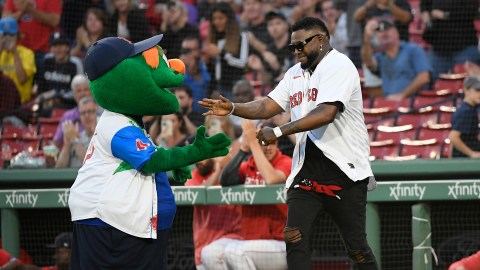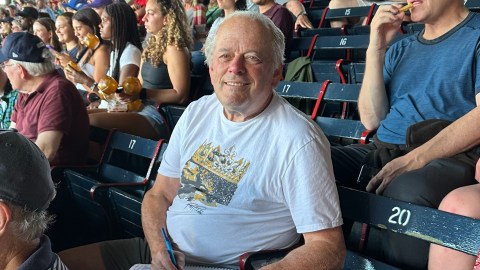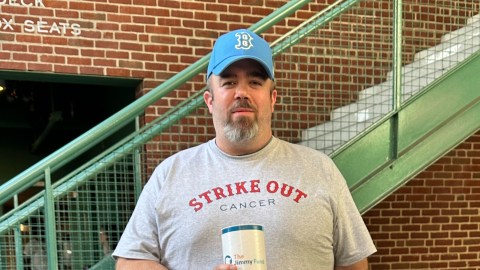This story originally appeared on the Jimmy Fund website. For more information on the Jimmy Fund, please visit jimmyfund.org.
In the playroom on the third floor of 44 Binney Street in Boston, boys and girls play with dolls, paint doilies and build with Legos. The children, from toddlers to elementary-school children, seem oblivious that roughly half of them merely have feathery remnants of hair.
At the Jimmy Fund Clinic, this is the norm. Children grin as they show their parents the valentines they have received. Pink bags of candy, soon to be handed out, sit out of reach in rows. The giant fish tank that divides this playroom and the reception area is covered with heart-shaped stickers, each featuring a phrase like “Be Mine” or “U R Sweet.”
Lisa Scherber hastily dances from place to place, humbly accepting praise from parents for organizing this “Sibling Day,” one of the many events that Lisa runs for children at the Jimmy Fund.
Officially, Lisa Scherber is the Child Life Specialist at the Jimmy Fund Clinic, but she is more familiarly referred to as “the play lady.” Her responsibility is to improve patients’ experiences at the clinic. Having left the festivities to check her email and finish some paperwork, Lisa sits in her small, cramped office. She leans forward like a bird, perched at the edge of her chair.
“What peanut butter sandwich is not the best when you have the Fluff on it?” she muses as she gestures with one outstretched hand, her palm up as if carrying a platter. “The medicine is the peanut butter, and the events I organize — they’re the Fluff. That’s what you need. You need the Fluff.”
Since her early twenties, Lisa has been working to add the “Fluff” to the Jimmy Fund Clinic. The clinic is on the third floor of the Dana-Farber Cancer Institute, which partners with Children’s Hospital in Boston to care for pediatric cancer patients. These two institutions treat over 2,000 children and teenagers every year. The Jimmy Fund Clinic staff sees between 50 and 60 patients every day, a number that has continually grown from 25, when Lisa began working at the clinic. Of all children diagnosed with cancer, over 80 percent live into their adult years and are considered cured.
The Jimmy Fund Clinic has traditional medical rooms, including examination rooms, an infusion room and specialized stem-cell transplant rooms. The most important spaces for Lisa, however, are the rooms that serve a less medical purpose. There is the entrance of the clinic where three giant stuffed animals sit: a polar bear, a giraffe and a tiger. Just past the brightly-lit reception area are the teen room and the playroom, the two waiting areas.
Lisa spends most of her mornings in the playroom. The fish tank and round glass portholes in one wall create a playful, nautical theme. Emerging from another wall is a boat the size of a small jungle gym. The structure, sunken into the floor and painted fire-engine red, is fully equipped with toy lifejackets, fishing rods and a small slide. The bow cradles small knitted hats for the children to wear.
The morning following “Sibling Day,” Lisa kneels in the boat with two girls. Stacey is four years old and wears a yellow T-shirt that reveals her pale, fragile limbs. Her head hosts a few wispy hairs where her hairline used to be. Her older sister sits in the boat, content to play with her baby doll. “I wanna go shopping!” declares Stacey, reaching towards a nearby picnic basket.
“Well,” Lisa says enthusiastically, “I can help you with all that stuff there.” On her hands and knees, she digs through a tremendous pile of toys in the hold of the boat. She exclaims, “Look! It’s a boot!” as she pulls out a blue Barbie boot and places it in Stacey’s eager hands. The two continue the search for shopping-related items. Stacey clenches her fist around a plastic asparagus. “Do you like asparagus?” Lisa asks as her face lights up with a grin. Stacey shakes her head “no,” yet she still drops the vegetable into the basket.
“Yeah,” Lisa adds, “it’s only good when it’s cooked juuust right.” She crawls towards the basket to contribute a toy doctor to the collection. She folds her tall frame to fit right into the hold next to her shipmate.
A nurse approaches. She interrupts, “It’s time to take your tubey out, Stacey,” referring to the clear plastic catheter that attaches to Stacey’s portable catheter (“portacath”). This disk-shaped apparatus was surgically placed under the skin of Stacey’s upper left chest for the duration of her chemotherapy treatment. The portacath allows fluid, usually chemotherapeutic medicines or hydration, to be directly delivered into her bloodstream without having to start a new intravenous line every time.
“Here?” Stacey asks hopefully, intent on continuing to play. The nurse shakes her head “no,” and Stacey screws up her face. She squeals an earsplitting “Nooo!” as the nurse gently pulls her up by the hand. Stacey looks at Lisa, points to her sister, still playing in the boat, and whimpers, “Why do I have to go and she gets to stay?”
“Hey Stacey, ” Lisa consoles without answering the question, maintaining a cheery attitude, “get ready, because we’ll wait for you to clean up! So you can help us?” Sulking but with something to look forward to, Stacey submits to the pull of the nurse’s hand, and they walk through the swinging doors. When they return in minutes, Stacey skips, surprisingly eager to help clean up. After they finish cleaning up, the girls leave with their mother. Lisa stands to return to her office for a quick breakfast.
When Lisa was first hired to work at the Jimmy Fund Clinic, her main role was to entertain children at the clinic in order to distract them from their treatment. Since then, Lisa has revolutionized her own position by creating positive experiences for the children even while they are not at the clinic to receive medical care. Emphasizing time outside of the clinic takes children away from the stress associated with the treatments they must receive.
“I realized, like, you gotta get these families out of the clinic,” Lisa explains, arriving in her office.
During her first year at the clinic, Lisa organized events to achieve this goal. She started the Summer Festival and the Christmas Party, which attracted about 800 people each. Since then, these annual events have become grand traditions. Lisa now runs group trips as well. She takes teens to spring training with the Boston Red Sox and on special weekends like the “Girls Weekend.” Every year, Lisa raises about $400,000 for these events. The Summer Festival in 2008 alone cost $70,000. Lisa’s fundraising activities range from managing donors to giving tours of the clinic. This money ensures that current and past patients can attend events for free.
“Once you’re a Jimmy Fund patient, even when you finish your treatment, you’re still part of the community, and this sort of celebrates that. It celebrates some of the successes that go through here,” Lisa explains earnestly, raising her eyebrows slightly. Suddenly her face brightens from its seriousness to its natural joviality. Grinning, she adds, “So it’s just a huge party.”
Lisa’s smile is ridged with permanent creases of a lifetime’s worth of smiles. Her grin is the widest part of her thin face, contrasting with her narrow nose. Her bob of brown hair and brown, deep-set eyes match her brown pants and shoes. The wall behind her is littered with photos of her family, including her two children, Matthew and Caroline, who are 11 and nine respectively, her husband and her dog. On top of the desk, alongside a napkin and a half-eaten bagel, sit a basket of lollipops and a symbolic jar of marshmallow Fluff.
Lisa does not spend much time in her office; she seems to use it more as a home base than as a workspace.
“I’m always running around doing this and that. It’s so hard to track me down sometimes, you know. I’m just all over the place!” Lisa rambles as she reaches to pick up a ringing phone. After a rapid “Hello” and “Oh! Thank you!” Lisa hangs up the phone and briskly shakes the mouse attached to her laptop to wake it up. She prints the two Celtics tickets that someone just donated. Grabbing the tickets as they come out of the printer, Lisa pops out of her chair. She scuttles through the clinic’s reception area, past the playroom, through a pair of swinging doors and into a hallway that features open infusion rooms. Hospital curtains split each room into four stations. Each station includes a television, a DVD player and a bed or chair for the patient. Lisa walks the hallway like an actor in a political drama: full of purpose, briefly chatting with people as she breezes past them. Quickly, Lisa finds Anna, a teenage girl with a winter hat. Her mother and father sit around her, speaking quietly to each other. They smile politely as they see Lisa approach. She halts and sings, “Aaannaaa!” drawing out each syllable. She pulls the tickets from behind her back and holds them out grandly for Anna to see.
Anna humors her by responding “Whaaat?” in the same singsong tone, and then she sees the tickets. “Ah! I would love to go!” Anna replies to the displayed tickets. “Now all you need to do is get some Revolution tickets. We’re all big soccer fans,” she hints.
“Perfect! Score!” Lisa erupts, handing the tickets to Anna. She gives a squawky laugh at her own pun, and Anna giggles along as well. “We get a lot of tickets, but we don’t have a lot of soccer fans,” Lisa clarifies. “So now we do!”
The guarded politeness in Ellen’s parents’ faces give way to more heartfelt smiles. Anna’s mother replies sincerely, “Thanks so much, Lisa.”
Before Lisa worked at the clinic, she knew what it was like to be a family member of a cancer patient at the Dana-Farber. At 16, Lisa would accompany her father to the hospital for his lung cancer treatments.
“My father passed away here,” she explains matter-of-factly, arriving back in her office. Her face tilts upward and she continues, “It’s the place that was so good to my dad so many years ago, and I think that’s part of what brought me here.” For a moment, Lisa sits in silence.
Lisa grew up with both her mother and father in Chelmsford, Mass., and then attended Framingham State College, where she studied media communications. She worked at Channel Four News, which was her supposed “dream job.” Four years into the job, she helped produce the Children’s Hospital Telethon. The children she saw immediately inspired her. As soon as possible, she offered to volunteer at the Jimmy Fund. On top of working at Channel Four, Lisa spent 12 hours a week at the clinic. Determined to change her career path, Lisa went back to school and studied for her Master’s degree in counseling psychology. Just after Lisa received her degree, the job of Child Life Specialist opened up.
As if suddenly realizing something, Lisa springs out of her seat to find tape, markers and a stack of paper to bring to the playroom. She bustles around her office, talking.
“My supervisor, whose job was just to be in the playroom, left to have a baby, so I was offered the position, and BABOOM!” she exclaims, revealing a hint of a Boston accent.
Her grin widens at the thought of such perfect timing. Lisa walks to the playroom with the supplies and gathers a small group of children and their parents. They trail behind her as she leads them to a glass-paned indoor bridge between the current and the new Dana-Farber buildings, the latter still an iron skeleton. On each beam are multiple, neon, spray-painted names. Lisa hands out the markers and paper and instructs the children to write their own names in big letters. Lisa and the parents then tape these names onto the glass, facing outside towards the beams.
“When we put up the names of the kids, the construction workers put them up on the beams,” Lisa clarifies, “When we take the names down it’s like ‘Find Waldo,’ ’cause you need to find their name before you can take it off the bridge.” Lisa chuckles and continues taping up new names as the children wave excitedly at a construction worker saluting back.
The smaller children at the Jimmy Fund are content with such minor activities, but teenagers need more to feel at home. For this reason, Lisa runs trips solely for teens. Last December, Lisa ran the “Girls Weekend.” She brought 26 sick and recovering girls into Boston for activities including manicures, shopping and photos taken by a professional photographer. Lisa recognizes that what may seem like a normal weekend to a healthy teenage girl can be much more for a girl suffering from cancer or its aftermath.
Leaving the children and their parents on the bridge to enjoy the scene, Lisa walks to her office and explains, “A friend has no idea what her friend is going through, supportive as a friend can be. But now, on this kind of trip, the girl sitting next to her knows exactly what it’s like to have this happen, and that is what is so important. I mean, at one in the morning, when I’m trying to get everyone to go to bed, that is the best feeling, because we don’t want them to want to go to bed. The girls were taking their wigs off and showing their scars — so important.”
Lisa has hurriedly put together a reunion of this trip for this Monday. “It’s how we roll. I never know what I’m doing. I can’t believe it’s already so soon!”
Lisa enters her office and picks up a boxed baby doll from under her desk. The doll was originally from her gift room: a room the size of a walk-in closet featuring colorful toys upon toys stacked on shelves up to the ceiling, hiding grey concrete walls. Lisa scurries off to bring the doll to a seven-year-old girl who is receiving chemotherapy on her birthday.
…………….
On a February afternoon a few weeks later, Lisa walks into a function room near Dana-Farber. From the high ceiling hang round lights like flying saucers, lighting the cream-colored walls. Caterers scramble to set up a gourmet buffet table. Lisa clashes with the creamy decor, wearing her bright pink and purple paisley shirt and a knee-length black skirt. Jen, the young fdolescent dpecialist, follows behind. Beaming, they admire the hall and step through a doorway to a room similar to the first. Easels line up along the walls and back to back in rows through the middle of the room, creating the effect of multiple hallways. Framed photographs of the 26 girls who went on the “Girls Weekend” rest on the easels. Each image is mounted with a white border, making each final piece the size of a full painting. The photos seem to glow, as if each is under a spotlight. Some are in black and white and others are in color, while some feature a part of a face and others are more classic full-face portraits.
Lisa smiles at the marvel she has created. “This is it. This is so amazing,” she decides. “This forces them to see the beauty they had forgotten about. When they’re diagnosed with cancer, they forget they are beautiful. Cancer gives the girls strength, and you can see the strength in the photos.”
With her long, narrow frame, Lisa stands in her signature stance, sticking one hip outwards and resting one wrist in the crook of her waist. She and Jen wait to open the doors at 4 p.m. They admire the picture of a redheaded girl on an easel right next to the doorway, separate from the other pictures.
“This is Caroline. She passed away about two weeks ago, so we put her picture kinda separate,” Lisa explains. She gestures as though pushing the close-up photo away from the rest. The lone picture highlights the truth that not everyone wins. The photo exhibit celebrates the successes of the other girls, providing a tribute to life while still acknowledging loss.
At four o’clock, people diffuse slowly into the space. Some girls wear hats, some sport synthetic wigs, some have a few inches of new hair and one is confident enough to keep her bald head exposed. As they find their pictures, Lisa stands with her hands laced together, pressed against her chin. “I feel like I’m Willy Wonka, and l just opened up the candy factory!” Lisa bursts, every line of her face beaming with raw, exposed happiness. She follows the girls as they find their pictures, awaiting their reactions, keeping her hands pressed at her chin eagerly, grinning widely each time she spots a smile.
A mother walks up to Lisa, carrying a box, the right size to carry one framed picture. “This is for you,” the woman says. “Thank you so much for everything.”
Lisa cheers like a child on Christmas morning as she gets on her hands and knees to open the box. Lisa’s jaw drops as she sees the framed image, which consists of smaller versions of each face displayed in the room. Caroline’s face looks out from the center of the frame. An extra easel waits for this special creation.
The picture of Elizabeth, a girl who finished chemotherapy six months ago, sits on its easel against a far wall. The portrait is in black and white except for the bright blue eyes, which remain their true color. When she comes in, she does not look at the pictures for very long. She remembers the trip more for new friends she made, like Caroline.
“When you’re sick,” she recalls, “even if you’re surrounded by a gazillion people, you’re still alone. It’s still your battle. It’s only you sitting in the chair with a needle in your arm. So on these trips that Lisa makes, you finally find kids who know what it’s like to be in high school, and be sick, and not be able to do what your other friends do, and how the smell of Purell makes you feel sick. Now you’re not as alone as you thought you were, and that is the best feeling ever. Lisa did the best thing she could for us, I think.”
After she sees Elizabeth, Lisa approaches Estherly, a girl who found her photo and is now speechless. She holds her hands up to her chin like Lisa. She then claps in excitement, keeping her eyes on the picture, unable to stop smiling. Aside, Lisa leans into Jen’s ear and whispers, “This is it.” Jen nods in happy agreement.
Lisa and her coworkers agree that these good moments outweigh the bad. The pain that comes in Lisa’s line of work is still a tremendous weight. Lisa often loses people she came to know and love, like Caroline. These tragedies never blend together or fade in Lisa’s mind. Whenever she sees the Red Sox, she thinks of Todd, the sports lover who begged her to organize a road trip. She still talks to the mother of Michael, a boy who passed away three years ago. Even after 17 years of her work, Lisa feels each loss as if it were the first. She attends between thirty and forty wakes every year and manages to keep an upbeat attitude by gaining some consolation from the pictures she sees. She is heartened to see photographs depicting a child at one of her events. When the reunion is over, the girls and their families filter out of the hall.
Once they all have left, Lisa explains, “You go to a wake, and you’ll see a picture of them at an event, and it’s like, oh my God!” Her voice crescendos to a pause, and then she clasps her hands together as she adds, more deliberately, “This. This was important to them.”
Lisa attributes her ability to persevere to the mutual encouragement of her coworkers. “To do this type of a job, you need a support group, because bad things happen,” Lisa reveals as her eyes stretch wide open. She motions toward Jen across the room. “We just have to … sort of not talk about it, but we also, sort of, like, you know, will go to the bathroom together and cry for two minutes. Then we’ll come out and meet the new patients. I mean, that’s the way it is. We’re all together, supporting each other. I can’t imagine working at this kind of place without having that. The kids need your big smile, and it’s not fake, so you have to make sure the sad side doesn’t pass over.”
Lisa has to keep going no matter what gets in her way. “When I think of Lisa,” says Elizabeth, “I think of something going completely wrong, and Lisa still laughing, with her smile plastered on her face, already on the next step to get us going, like it’s no big deal. It’s like she’s always running a hundred miles an hour.”
The next day, Lisa stands on the glass bridge with a new group of children. They watch as a crane lowers a new beam, covered with yesterday’s names, into place. The children’s eager hands and noses press against the glass as they look upwards in sheer amazement. Lisa stands behind them, the path of her eyes following theirs.
“I love it here,” she reflects. “I will be here until they figure out the cure.” She then sparks up, her ever-present grin widening, “I’ll be this old lady wheeling around.” Giggling, Lisa mimes teetering around in her own wheelchair. Her animated smile slowly fades as she adds more seriously, “It’s true. I love what I do.”



